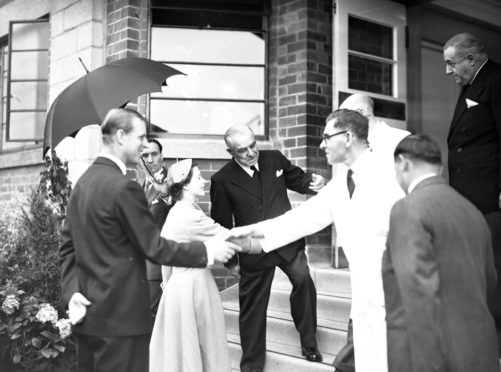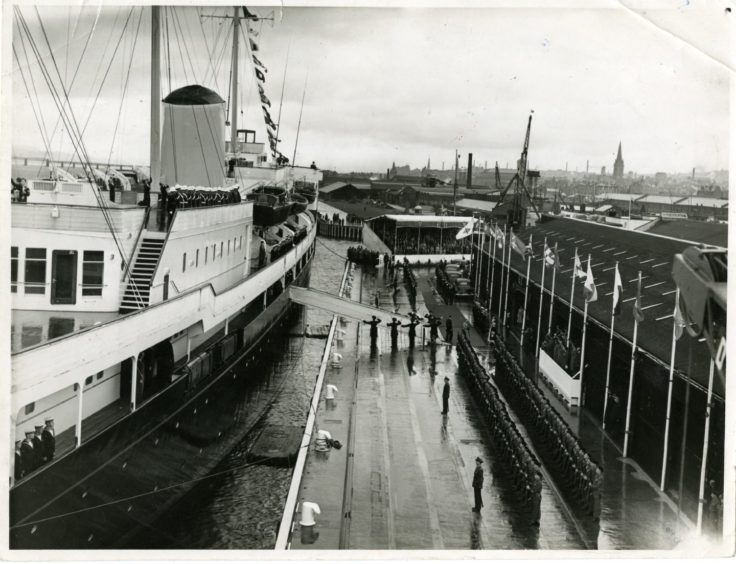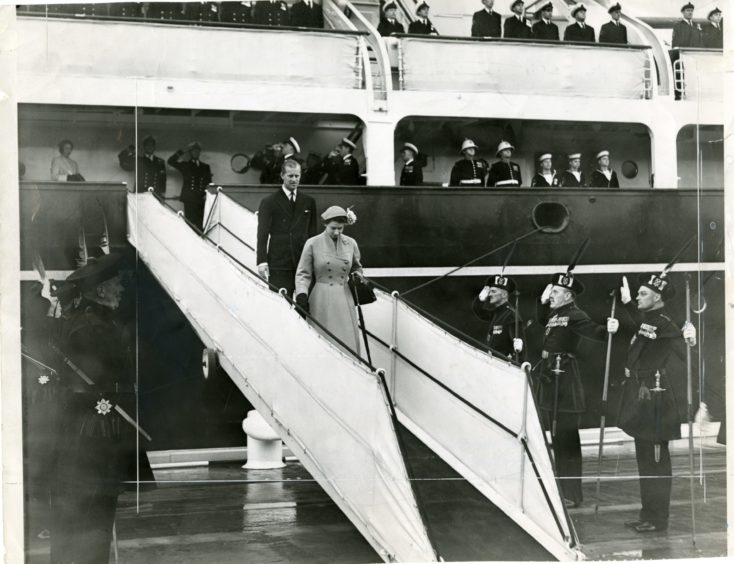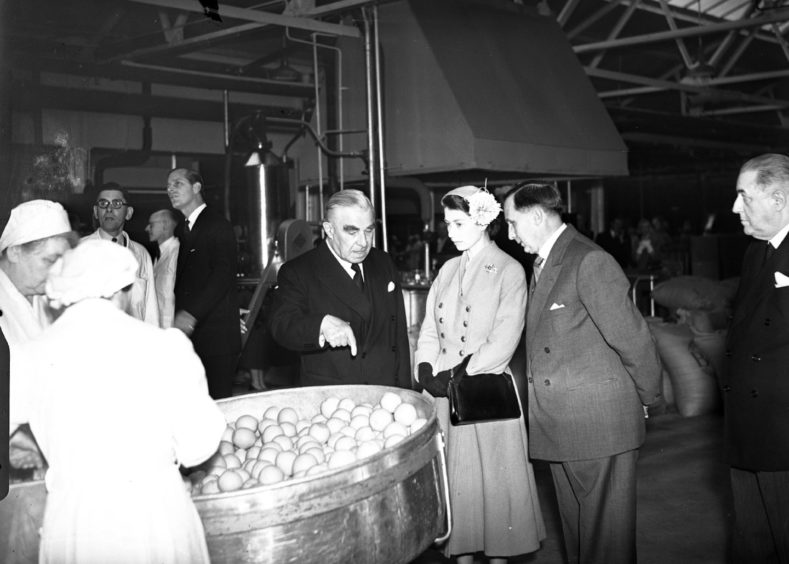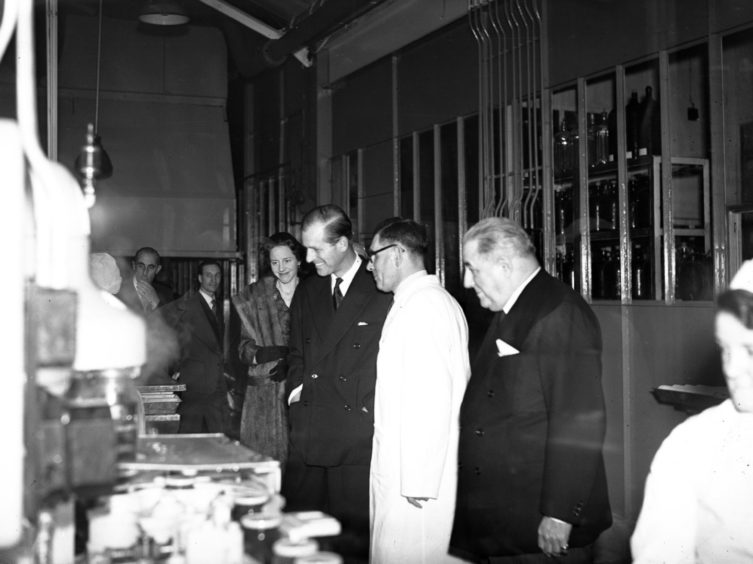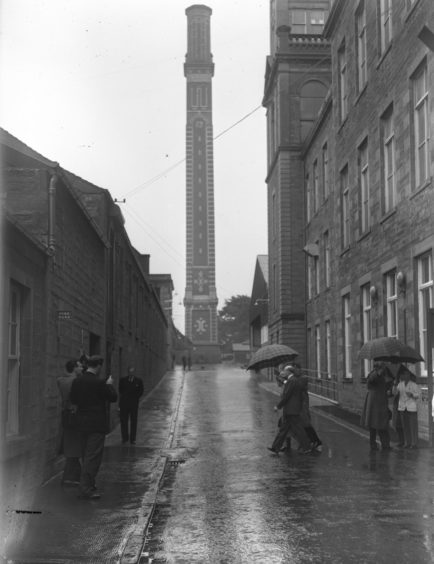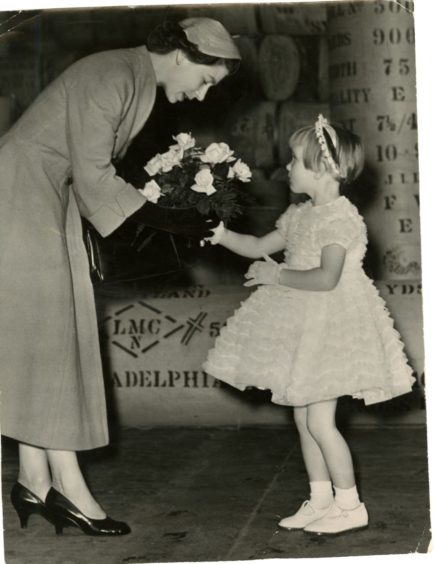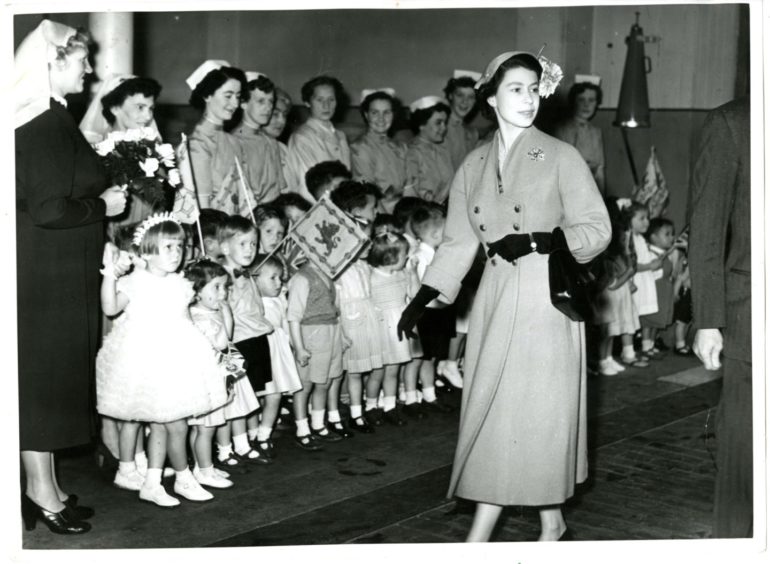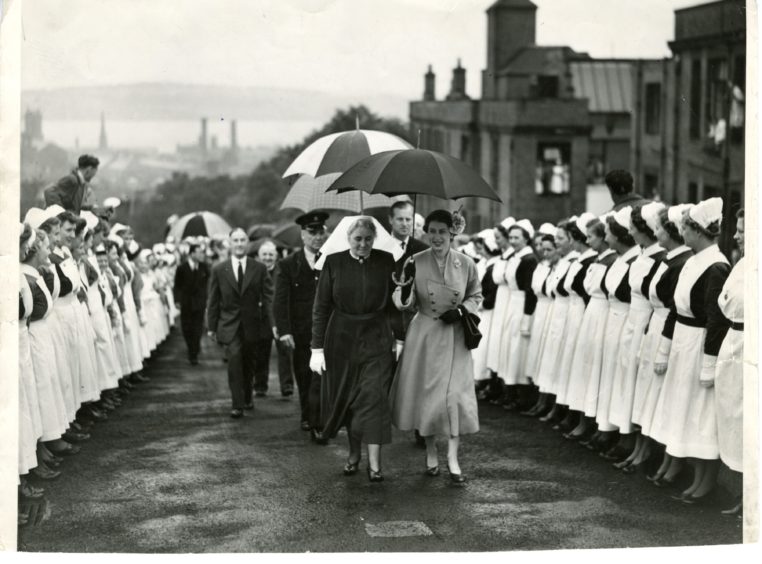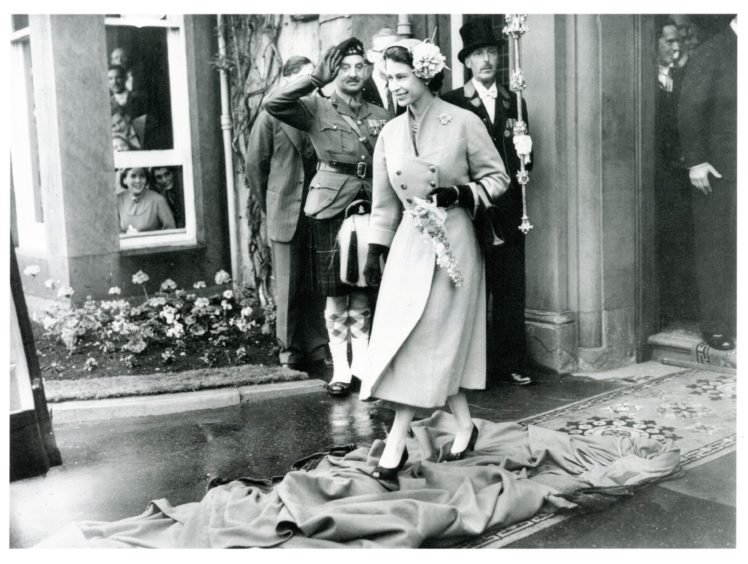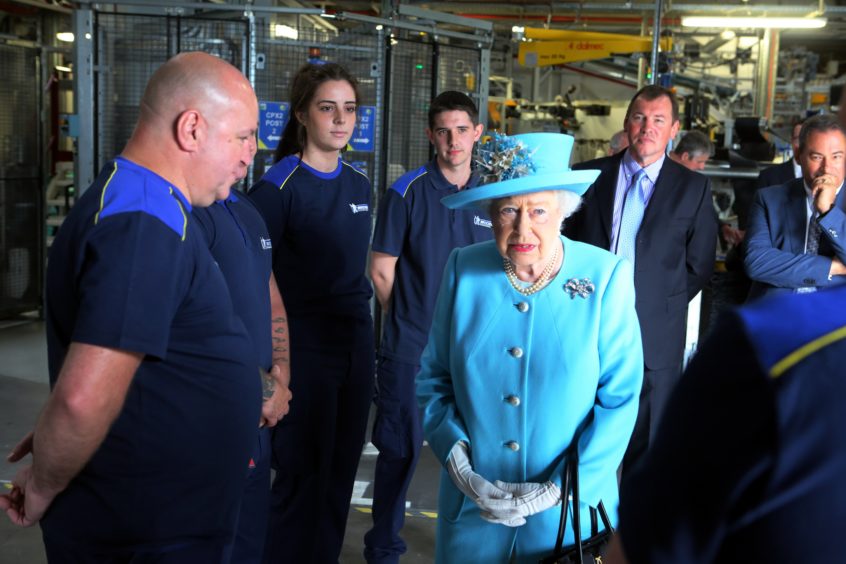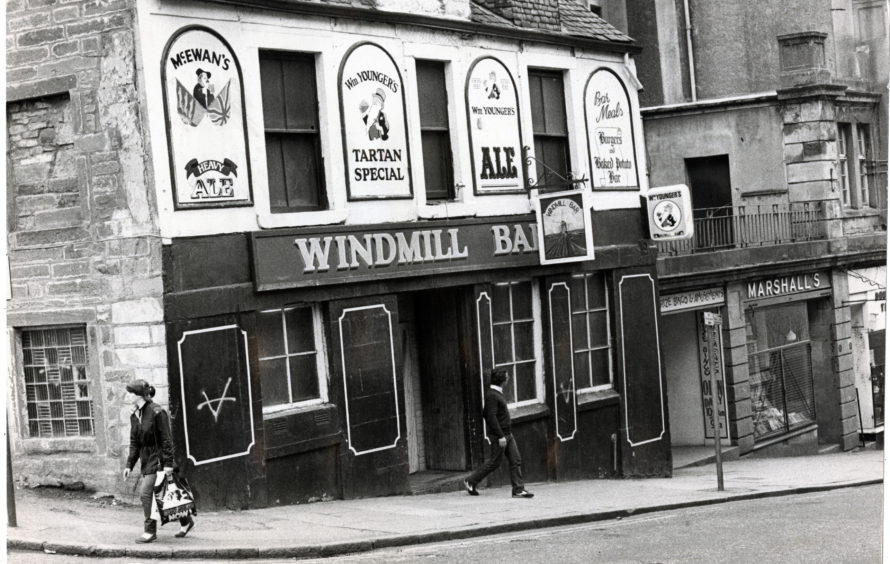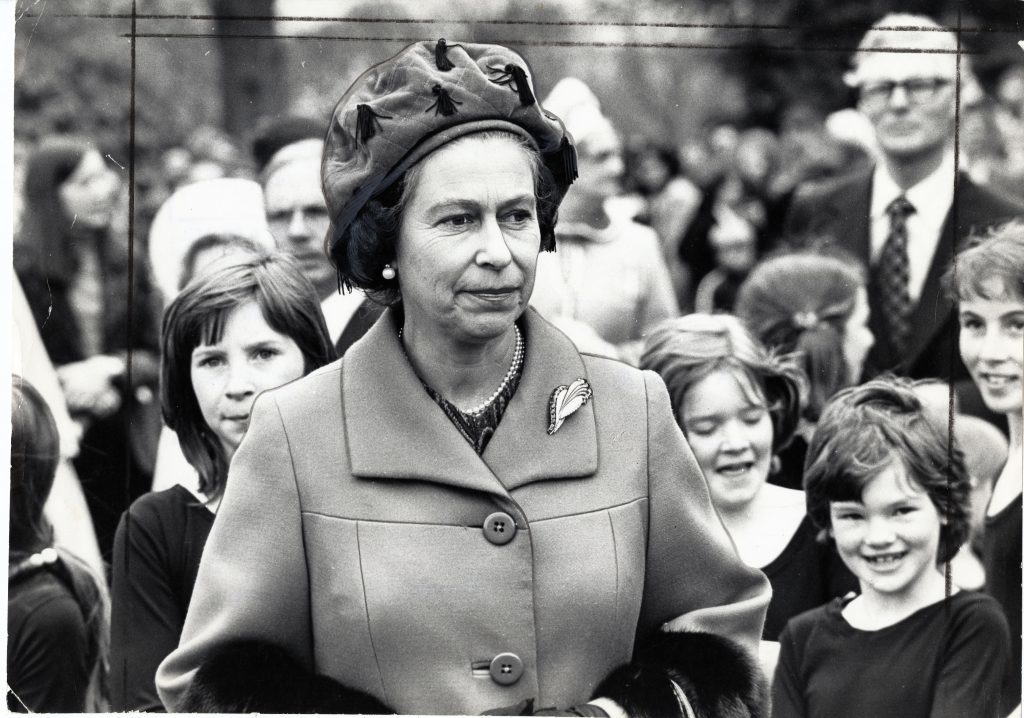The late Prince Philip ended up covered in marmalade on a rain-soaked royal visit to Dundee in 1955.
The Duke of Edinburgh, who has died at the age of 99, was wiped down following the sticky encounter on a visit to the Keiller’s factory in Mains Loan.
Hundreds of motor horns
Earlier in the day thousands of people watched the Royal Yacht Britannia pass Broughty Castle from every conceivable vantage point as she glided towards her berth at King George Wharf on June 28 1955.
Hundreds of motor horns signalled her arrival from Norway following the Queen and Duke of Edinburgh’s visit to Oslo.
People lined the road from Barnhill to Stannergate on the Dundee side and from Tayport to Newport on the Fife side to catch a glimpse of the Britannia.
The Queen, wearing a blue headscarf and warm camel coat, stood with Prince Philip on the boat deck just below the bridge and waved their reply to the cheers and the welcoming sirens of the ships.
A gust of wind then caught the bows of the Britannia.
There was a creaking of woodwork as one of the catamarans which had been placed in position to keep the ship off the quay took the weight of the Britannia.
By this time the Queen had gone below but Prince Philip remained on deck under lowering skies in a navy blue raincoat to watch the lines being thrown ashore to mark the start of the berthing operations.
The traditional red carpet was laid between the gangway and the royal car which was a maroon-coloured Rolls-Royce.
The Queen and Prince Philip were piped ashore and were presented to the official reception party which was headed by Lord Provost William Hughes, the Lady Provost and Scottish Secretary James Stuart.
They were cheered out of the harbour by employees of the Harbour Trust and firms in the dock area.
Long after the royal couple had left the Britannia, seamen and landsmen alike wandered along the dockside to wonder at her beauty.
Crowds surged forward
The royal car turned from Commercial Street into Murraygate on its way to visit Keiller’s factory.
Crowds surged forward into the middle of the street and several people were literally pressed against the car as it passed by.
They arrived at Keiller’s where they saw Spanish oranges being made into marmalade and showed great interest in the different processes.
Prince Philip went very close to a pan as it was being emptied and a spurt of marmalade caught the trouser leg of his navy blue lounge suit.
He took out his handkerchief and rubbed it until Keiller’s chief chemist Allen Pouncey got a cloth to clean him up.
At the inspection conveyor belt, both the Queen and Prince Philip stopped to watch the jars of ‘Little Chip’ orange marmalade pass the penetrating light.
He said: “That is what you do if you want to go to sleep.
“Count things as they are going by.”
At the quality check counter he tasted both types of marmalade and chatted with the inspectors.
The party continued to Lochee and over 25,000 schoolchildren braved the rain to line the route along the Kingsway.
The rain did nothing to quench their enthusiasm – not even those who waited for 90 minutes without waterproofs.
Teachers did their best to shelter some of the smaller ones under umberellas and raincoats.
Bedraggled Union flags and Lion Rampants were used by some children to cover their heads.
The children got their reward when the Queen passed and gave them a beaming smile on the way to Camperdown Works which was for a time the world’s largest jute works, boasting 820 power looms, 150 hand looms and more than 5,000 workers.
The greatest landmark at Camperdown Works was the 282-foot high brick chimney Cox’s Stack which was built by James MacLaren in 1866 and modelled on Italian bell towers.
The chimney stalk could be seen from almost any point in the city.
The Cox family built it to ensure smoke from the furnaces was carried well above the nearby workers’ houses.
The Queen and Prince Philip were given a tour of the weaving factory by Sir William Walker, chairman and joint managing director of Jute Industries Limited.
From a platform in the lower factory the Queen and Prince Philip saw the impressive sight of 438 looms in one floor all working below them.
The royal couple went down to speak to the workers including 58-year-old Margaret Cooper whose family had strong connections to Camperdown Works.
Mrs Cooper had been there for 40 years and also serving in the same department were her four daughters who were all weavers and the husbands of three of the daughters who were tenters.
Four-year-old Ann Bonar, who was the “oldest sitting tenant” of the works’ nursery having been there since she was six months – was chosen to present the Queen with a bouquet of cream roses before her departure.
“They all look very sweet,” said Prince Philip to the nursery’s matron.
The royal couple moved on to Dundee Royal Infirmary afterwards to open the new radio diagnostic department.
The matron Annie O’Dey offered the Queen a pair of embossed silver scissors in a blue padded case before the ceremony.
“I hope they will cut,” she said.
One snip was enough to sever the broad white silk ribbon across the double doors.
Dr Cecil Pickard, consultant radiologist and chief of the department, and Dr George Grant, consultant radiologist, conducted the royal couple on a 15-minute tour of the new facility.
The rain had thinned the crowds by the time the pipes and drums of the 4/5th Battalion of The Black Watch led a guard of 180 to the City Square.
Shortly before 12.45pm the royal couple arrived to cheers from the crowd to have lunch in the City Chambers.
The couple left afterwards along Riverside Drive before a final visit to Queen’s College which would go on to become the University of Dundee.
Today is #birthday of HRH Prince Philip, Duke of Edinburgh, pictured here visiting Queen's College #Dundee in 1955 pic.twitter.com/QPD7xv9tg6
— UoD Archives & RM (@UoD_Archives_RM) June 10, 2014
Four undergraduates provided a ‘Walter Raleigh’ touch to proceedings.
The Queen and Prince Philip were walking to their car when the students laid down their gowns on the wet road between the door of the college and the car.
The Queen smiled her thanks.
The couple left for Edinburgh following the visit.
The Duke of Edinburgh turned to verse during Queen’s Jubilee visit to Dundee in 1977
The city of Dundee has been graced with numerous visits from the Queen.
The Courier’s earliest photograph of the Queen in Dundee is of Princess Elizabeth shopping with her grandmother, the Countess of Strathmore, at Webster’s Toy Shop in Whitehall Crescent in the 1930s.
Following her visit in 1955 she continued to show an interest in Dundee’s industry when she returned to the city in 1969, taking in Douglasfield Works and The NCR Gourdie Factory.
In 1977, she wowed onlookers with a stunning outfit as she left a function at the City Chambers.
The Queen’s jubilee visit also including planting a tree at Camperdown and meeting a group of Sea Cadets.
Prince Philip famously stopped at the Windmill Bar in the Hilltown during the visit and pointed up at the windows before acknowledging the cheers of the regulars.
In the evening, after the visit, staff and regulars agreed to send a letter to the duke about the bar.
They produced three poems which were copied out on the back of a print of the bar and handed in to the Queen’s bodyguard at Dundee City Chambers.
They were amazed some days later to receive a poem in reply, simply titled The Windmill Bar and signed Philip, thanking the regulars for their welcome.
In 1987 the Queen received an enthusiastic welcome in Dundee.
During her visit she opened WL Gore, went on board the Discovery and greeted the crowds who came out to meet her in City Square.
The 1990s saw the Queen make two trips to the City of Discovery, the first in 1991 to visit Expo 800 and the second to open the University of Abertay in 1998.
In 2007, the Queen arrived in the city wearing a striking red coat and hat, which she wore when visiting the University of Dundee Chaplaincy and The Shore, while accompanied by Prince Philip.
The couple returned to the city in 2016 and officially opened the Leverhulme Research Centre for Forensic Science at Dundee University.
They also met apprentices working at the Michelin tyre factory in Baldovie before the Queen visited the waterfront and opened Slessor Gardens.
